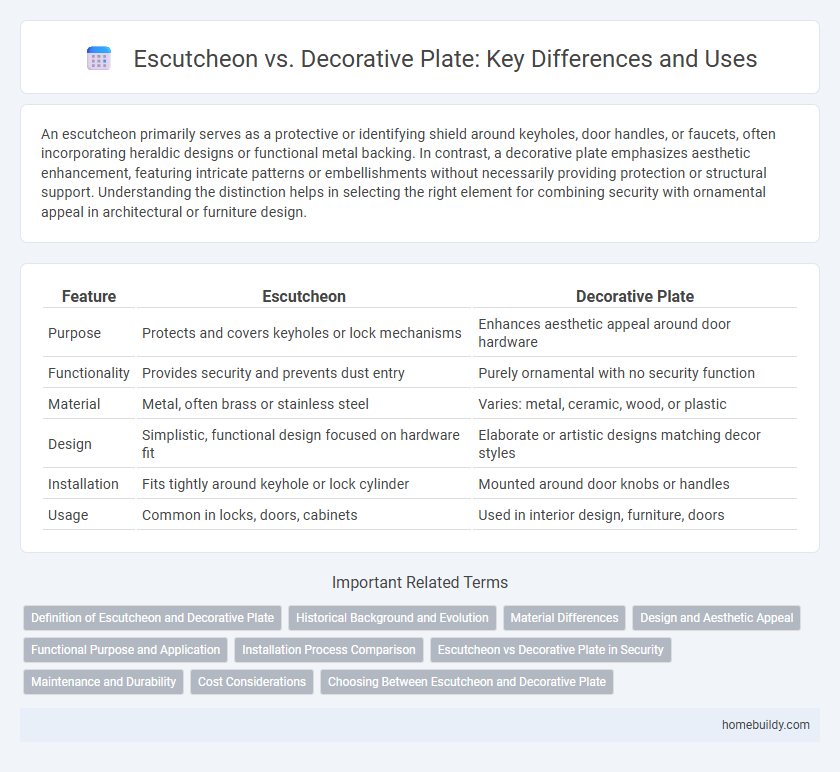An escutcheon primarily serves as a protective or identifying shield around keyholes, door handles, or faucets, often incorporating heraldic designs or functional metal backing. In contrast, a decorative plate emphasizes aesthetic enhancement, featuring intricate patterns or embellishments without necessarily providing protection or structural support. Understanding the distinction helps in selecting the right element for combining security with ornamental appeal in architectural or furniture design.
Table of Comparison
| Feature | Escutcheon | Decorative Plate |
|---|---|---|
| Purpose | Protects and covers keyholes or lock mechanisms | Enhances aesthetic appeal around door hardware |
| Functionality | Provides security and prevents dust entry | Purely ornamental with no security function |
| Material | Metal, often brass or stainless steel | Varies: metal, ceramic, wood, or plastic |
| Design | Simplistic, functional design focused on hardware fit | Elaborate or artistic designs matching decor styles |
| Installation | Fits tightly around keyhole or lock cylinder | Mounted around door knobs or handles |
| Usage | Common in locks, doors, cabinets | Used in interior design, furniture, doors |
Definition of Escutcheon and Decorative Plate
An escutcheon is a protective or ornamental plate surrounding a keyhole, door handle, or faucet, primarily designed to cover gaps and prevent damage. A decorative plate serves mainly aesthetic purposes, enhancing the appearance of hardware without necessarily providing protection or structural support. While escutcheons emphasize functionality and security, decorative plates focus on visual appeal and style.
Historical Background and Evolution
Escutcheons date back to medieval heraldry, originally serving as shields displaying family crests and coats of arms, symbolizing identity and protection. Over time, the term expanded in architecture and hardware to describe protective plates around keyholes and door handles, emphasizing functionality alongside decoration. Decorative plates evolved more as aesthetic enhancements, often lacking the historical symbolism embedded in traditional escutcheons, reflecting a shift from heraldic significance to ornamental design.
Material Differences
Escutcheons are typically crafted from durable metals like brass, stainless steel, or bronze to provide secure protection around keyholes and locks, ensuring longevity and resistance to wear. Decorative plates often utilize a broader range of materials, including lightweight alloys, plastic, or wood, prioritizing aesthetic appeal over heavy-duty functionality. The material choice directly impacts the escutcheon's ability to shield door mechanisms, whereas decorative plates mainly enhance visual design without robust protective properties.
Design and Aesthetic Appeal
An escutcheon typically serves as a protective or functional cover for keyholes or door hardware, featuring a minimalist design that emphasizes subtlety and durability. Decorative plates prioritize aesthetic appeal with intricate patterns, varied materials, and ornamental details that enhance interior or exterior design elements. While escutcheons blend into the overall hardware, decorative plates act as focal points, contributing significantly to the visual character of doors or furniture.
Functional Purpose and Application
An escutcheon primarily serves as a protective cover for keyholes or lock cylinders, preventing dirt and wear while providing security. Decorative plates focus mainly on aesthetic enhancement, offering ornamental appeal without necessarily contributing to protection or function. In practical applications, escutcheons are essential for maintaining lock integrity in doors, while decorative plates are used to complement interior design through visual accents.
Installation Process Comparison
The installation process of an escutcheon involves precise alignment and securing it directly onto the plumbing fixture or door hardware to ensure a tight seal and aesthetic finish. In contrast, decorative plates are often mounted more loosely, focusing primarily on visual appeal without the need for a waterproof or airtight seal. Escutcheons typically require measurements tailored to pipe diameters or hardware dimensions, whereas decorative plates allow for more flexibility in size and placement during installation.
Escutcheon vs Decorative Plate in Security
An escutcheon provides enhanced security by shielding the keyhole or lock cylinder from tampering, drilling, and picking, offering a robust defense against forced entry. In contrast, a decorative plate primarily serves aesthetic purposes and lacks the reinforced materials or design features necessary for effective protection. Security-grade escutcheons often incorporate hardened steel and anti-drill plates, making them essential components in secure door locking systems compared to purely ornamental decorative plates.
Maintenance and Durability
Escutcheons offer superior durability compared to decorative plates due to their robust metal construction, which resists wear and corrosion over time. Maintenance of escutcheons is minimal, requiring only regular cleaning to prevent buildup of dirt and grime. Decorative plates, often made from lighter materials, may need more frequent replacement or touch-ups to maintain their appearance.
Cost Considerations
Escutcheons typically cost less than decorative plates due to simpler designs and thinner materials, making them a budget-friendly option for protecting keyholes or plumbing fixtures. Decorative plates often involve intricate craftsmanship or premium materials, driving up their price significantly. Choosing between the two depends largely on balancing aesthetic desires with practical budget constraints.
Choosing Between Escutcheon and Decorative Plate
Choosing between an escutcheon and a decorative plate depends on the desired function and aesthetic impact. Escutcheons primarily serve to protect door hardware and conceal keyholes or mounting holes with a slim, functional design. Decorative plates emphasize ornamental appeal, often featuring intricate patterns that enhance the visual style of doors or furniture without focusing on hardware coverage.
Escutcheon vs Decorative Plate Infographic

 homebuildy.com
homebuildy.com